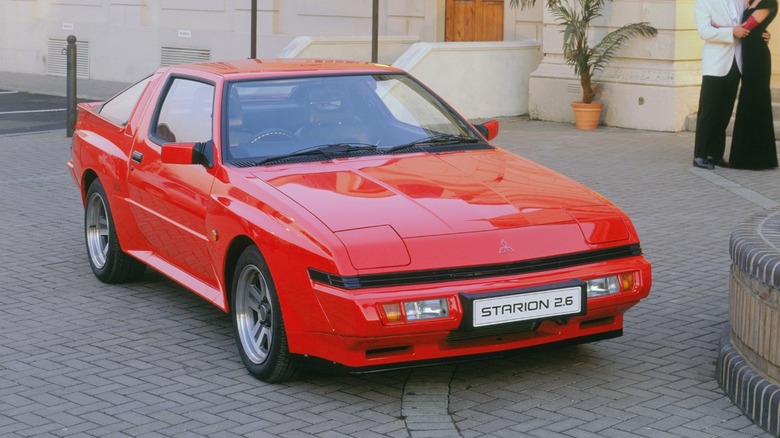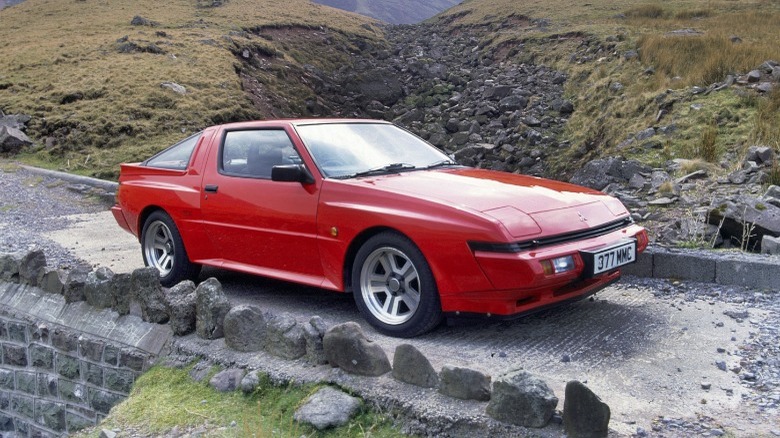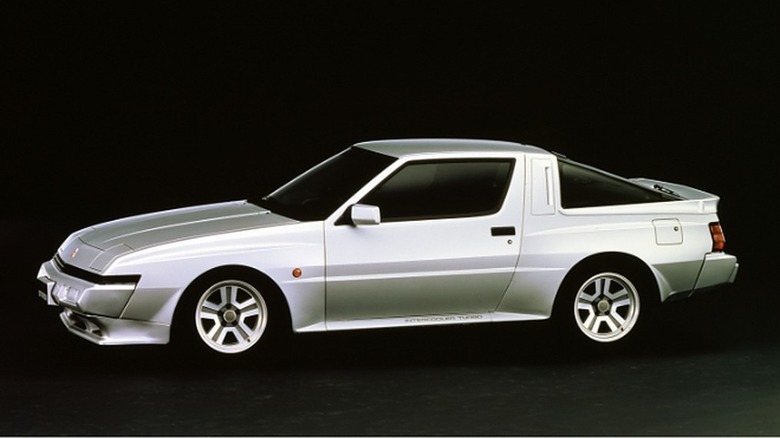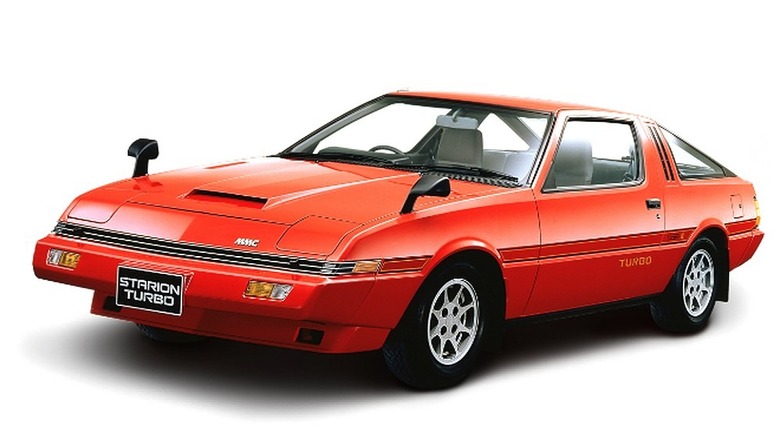The 80s Mitsubishi And Chrysler Crossover Car You Forgot Existed
Before it became part of the Nissan-Renault alliance in 2016, Japanese auto giant Mitsubishi had a string of highly impressive and sporting automobiles. Mitsubishi launched its first four-wheeled car in 1917 with the Model A. It wasn't until the 1960s that the automaker found its form with the first-gen Colt Galant, accompanied by similar success from the brand's commercial vehicle department.
Hungry for expansion to burgeoning worldwide markets, Mitsubishi sold a 15% stake to U.S. legacy automaker Chrysler in 1971. The turn of events led to the introduction of the Galant-based Dodge Colt in the US market that same year, the first rebadged Mitsubishi car sold by Chrysler. The deal pushed Mitsubishi's annual production to above 250,000 vehicles, further bolstered as Chrysler debuted the Sigma (also based on the Galant) in Australia by 1977.
The partnership went further in the rebadging business with the Galant-based Dodge Challenger (based on the Galant Lambda), Plymouth Sapporo, and Dodge Conquest, the latter known as the Mitsubishi Starion in other parts of the world.
Mitsubishi Starion/Dodge Conquest: a forgotten classic?
Mentioning the Mitsubishi name brings to mind a mishmash of rally-conquering sport sedans like the Lancer Evolution series and exotic two-door sporty coupes like the GTO or 3000 GT. But before those vehicles permanently etched their place in automotive history, Mitsubishi had the Starion in the 1980s, a two-door coupe with a classic wedge body style, a turbocharged gas engine, and a host of innovative technology.
The Starion/Conquest was one of the first Japanese turbocharged vehicles to have electronic fuel injection, something it needed to upset the competition led by the Mk1 Mazda RX-7, Nissan 280Z, and Toyota Supra. The Starion's rounded wedge styling and pop-up headlights were distinctively cool. Inside, the driver and passenger are shrouded in modern amenities like automatic climate control (with cabin sensors and a photosensor to measure the amount of sunlight inside the cabin), an adjustable graphic equalizer for the audio system (a big deal in the 1980s and early 1990s), and power windows that can raise or lower 30 seconds after turning the ignition off.
Powerful turbocharged engines
Best of all, the Starion/Conquest's mechanicals were top-notch. Depending on the market, it came with two engines. The American Dodge Conquest had a 2.6-liter turbocharged four-cylinder engine with single overhead cams (SOHC) and a five-speed manual transmission, pumping 145 horsepower to the rear wheels. Later models came with turbo upgrades, an intercooler, and hemispherical heads with three/four valves per cylinder to help the engine churn out up to 197 horsepower.
However, Japan and other markets got a smaller yet peakier 2.0-liter Sirius G63B turbocharged four-banger with single overhead camshafts, progenitor of the bulletproof and endlessly tunable 4G63 engine in the Galant VR and Lancer Evolution I to VIII. Although the early Sirius engine only had a SOHC valvetrain with two valves per cylinder, it had Lancaster twin-balance shafts, fuel injection, and a feisty turbocharger.
The 2.6 and 2.0-liter engines pumped out similar power figures, but the former had slightly more torque, and the latter had a higher redline. No matter which engine, the Starion went from zero to 60 mph in 7.5 seconds and had a 135 mph top speed, quicker than a Porsche 944.
Mitsubishi added a couple of upgrades to fend off newer generations of the Mazda RX-7 and Toyota Supra, like an updated intercooler, a limited-slip differential, and a widebody kit, calling it the Starion ESI-R or the Dodge Conquest TSI (Turbo Sport Intercooled). And by 1988, the Starion was pumping out 188 horsepower and 234 pound-feet of torque.
And with the Starion/Conquest's front-engine, rear-drive architecture with independent front/rear suspension, four-wheel disk brakes, and a trick limited-slip differential, it won the admiration of racing fans, particularly in the SCCA championships of the 1980s and early 1990s.
The birth of Diamond Star
Mitsubishi's annual production soared to more than a million cars in the 1980s. And by the time the Starion/Conquest debuted in 1982, the Mitsubishi-Chrysler relationship began to go south. Mitsubishi was expanding in Europe by the mid-1970s, and this decision left a bad taste in the Chrysler brass' mouths, which birthed a see-saw of concerning accusations.
Chrysler found it unacceptable that Mitsubishi was competing with the brand in other markets. On the other hand, Mitsubishi was having trouble with Chrysler's financial struggles and its propensity to interfere heavily with the brand's corporate strategy and product planning. And because of this, Chrysler distanced itself heavily from marketing the Dodge Conquest.
It's the reason why promotional brochures for the Dodge/Plymouth Conquest had the words "Imported by Chrysler Corporation and built by Mitsubishi Motors Corporation" on the top of the first paragraph as a winking eye that something's brewing underneath. Despite their troubles, Chrysler and Mitsubishi agreed to unify and form a vehicle manufacturing agreement in Normal, Illinois, called Diamond-Star Motors by 1985.
As for the Starion/Conquest, production ended in Japan by 1989. Diamond Star began churning out the Mitsubishi Eclipse, Plymouth Laser, and Eagle Talon as successors to what many consider as a forgotten sporting icon of the 1980s. The Mitsubishi Starion/Dodge Conquest was so iconic that it earned a starring role in the film Cannonball Run II, impressive given the cast list includes other legendary autos like the Mercedes-Benz 300 SL, Pontiac Firebird, and the Lamborghini Countach.



